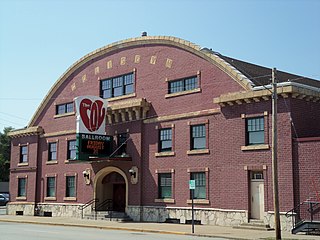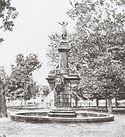
Turners are members of German-American gymnastic clubs called Turnvereine. They promoted German culture, physical culture, and liberal politics. Turners, especially Francis Lieber (1798–1872), were the leading sponsors of gymnastics as an American sport and the field of academic study.

Scott County is a county located in the U.S. state of Iowa. As of the 2020 census, the population was 174,669, making it the third-most populous county in Iowa. The county seat is Davenport.

Turner Hall is a historic athletic club facility at 1034 North 4th Street in Milwaukee, Wisconsin. Named using the German "Turnen", meaning gymnastics or physical fitness, it is significant for its association with the American Turners, a German-American athletic, cultural, and political association. The Milwaukee group was founded in 1853 under the title, "Socialist Turnverein"; its leaders included Socialist Congressman Victor Berger. The building is one of the largest and most distinctive surviving buildings associated with the Turner movement, and was designated a National Historic Landmark in 1996. It is now used as a performance and meeting venue.
Davenport, Iowa, was part of the Louisiana Purchase. In 1814, during the War of 1812 the British military, along with the Saux and Fox Indian tribes fought against the Americans near Davenport. In August, Major Zachary Taylor, later President, fought a battle east of what is now Credit Island Park, in Davenport. An outpost was set up at Fort Armstrong and George Davenport and Antoine LeClaire were stationed there.

The Village of East Davenport, also known simply as The Village, is located along the Mississippi River on the southeast side of Davenport, Iowa, United States. It was listed as a historic district on the National Register of Historic Places in 1980 as the Davenport Village. At the time of its nomination it included 145 contributing properties, most of which were working-class housing.

St. Anthony's Catholic Church is a parish church in the Diocese of Davenport. The parish complex is located in downtown Davenport, Iowa, United States, at the corner of Fourth and Main Streets. It is the first church congregation organized in the city of Davenport and the second Catholic congregation, after St. Raphael's in Dubuque, in the state of Iowa. The parish buildings were listed on the National Register of Historic Places as St. Anthony's Roman Catholic Church Complex in 1984. The designation includes the church and the former school building, which is the parish's original church building and the oldest standing church building in Iowa. The designation also included the rectory, which was partially torn down in 2009. The complex was also listed on the Davenport Register of Historic Properties in 1992 as St. Anthony's Church Square. The property has been known historically as Church Square. In 2020 the parish buildings, except for the parish center, were included as contributing properties in the Davenport Downtown Commercial Historic District. Because of its recent construction date, the parish center is excluded as a contributing property.

First Baptist Church is located in central Davenport, Iowa, United States. It was listed on the National Register of Historic Places in 1983 as Calvary Baptist Church/First Baptist Church. It is affiliated with American Baptist Churches USA.
Turner Hall were gathering places for German immigrant Turners and may refer to:

The J.H.C. Petersen's Sons' Store also known as the Petersen Harned-Von Maur Store Building and the Redstone Building, is a historic building in Davenport, Iowa, United States. It was individually listed on the Davenport Register of Historic Properties and on the National Register of Historic Places. In 2020 it was included as a contributing property in the Davenport Downtown Commercial Historic District. The former department store building was modeled on the Rookery Building in Chicago.

St. Katherine's Historic District is located on the east side Davenport, Iowa, United States and is listed on the National Register of Historic Places. It is the location of two mansions built by two lumber barons until it became the campus of an Episcopal girls' school named St. Katharine's Hall and later as St. Katharine's School. The name was altered to St. Katharine-St. Mark's School when it became coeducational. It is currently the location of a senior living facility called St. Katherine's Living Center.

The Hose Station No. 1 is a historic building located in downtown Davenport, Iowa, United States. It was listed on the National Register of Historic Places in 1983 and on the Davenport Register of Historic Properties in 1999. In 2019 it was included as a contributing property in the Davenport Motor Row and Industrial Historic District.

The Col Ballroom is a historic building located in the West End of Davenport, Iowa, United States. It was listed on the National Register of Historic Places and on the Davenport Register of Historic Properties as the Saengerfest Halle.

The Hamburg Historic District, also known as the Gold Coast, is a residential neighborhood located on a bluff northwest of downtown Davenport, Iowa, United States. It is listed on the National Register of Historic Places in 1983. In 1999, it was listed on the Davenport Register of Historic Properties The historic district is where the city's middle and upper-income German community built their homes in the 19th and early 20th centuries. Germans were the largest ethnic group to settle in Davenport.

West Third Street Historic District is located on the west side of downtown Davenport, Iowa, United States. It was listed on the National Register of Historic Places in 1983. The historic district connects the central business district with the working-class neighborhoods of the West End. Its historical significance is its connection to Davenport's German-American community. Germans were the largest ethnic group to settle in Davenport.

The Northwest Davenport Turner Society Hall is a historic building located in the old northwest side of Davenport, Iowa, United States. It has been listed on the National Register of Historic Places since 1979. The Northwest Davenport Turner Society Hall is significant for its association with Davenport's German community, which was the city's largest and most influential immigrant group. It also played an important role in the civic and cultural life of the northwest Davenport German community.

The D.C. Eldridge House is a historic building located on the east side of Davenport, Iowa, United States. It has been listed on the National Register of Historic Places since 1984.

The Scott County Courthouse in Davenport, Iowa, United States was built from 1955 to 1956 and extensively renovated over a ten-year period between 1998 and 2009. It is the third building the county has used for court functions and county administration. It is part of a larger county complex that includes the county jail, administration building and juvenile detention facility. In 2020 the courthouse was included as a contributing property in the Davenport Downtown Commercial Historic District on the National Register of Historic Places.

This is intended to be a complete list of the properties and districts on the National Register of Historic Places in Downtown Davenport, Iowa, United States. Downtown Davenport is defined as being all of the city south of 5th Street from Marquette Street east to the intersection of River Drive and East 4th Street. The locations of National Register properties and districts may be seen in an online map.
Frederick George "Fritz" Clausen (1848–1940) was a Danish-born architect who came to the United States in 1869 and founded an architectural practice in Davenport, Iowa. The firm that he founded, presently named Studio 483 Architects, is still in business today, the oldest firm in continuous practice in the state of Iowa. Clausen has been termed the "premier 19th century architect" of Davenport, Iowa.

The Lambrite–Iles–Petersen House is a historic home located in the Hamburg Historic District in Davenport, Iowa, United States. The district was added to the National Register of Historic Places in 1983. The house was individually listed on the Davenport Register of Historic Properties in 2012. This was the first residence built in the city in the Italian villa style and one of the earliest examples in the state of Iowa. The house is named for three of its early owners: Joseph Lambrite, a lumber mill owner who built the house, Dr. Thomas Iles, a physician, and John H.C. Petersen, who founded Davenport's largest department store that grew to become Von Maur.




















